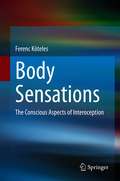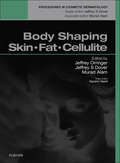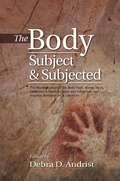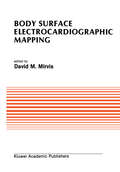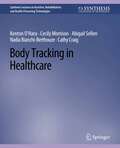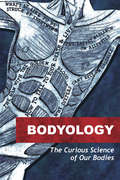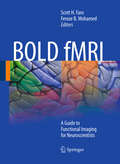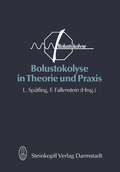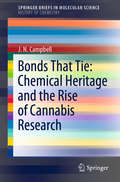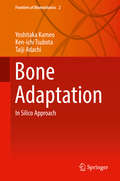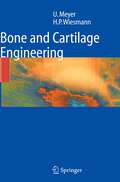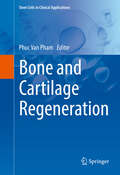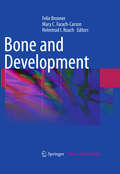- Table View
- List View
Body Reshaping through Muscle and Skin Meridian Therapy: An Introduction to 6 Body Types
by Jeonhee JangBody Reshaping through Muscle and Skin Meridian Therapy: An Introduction to 6 Body Types shows you how your weight and body shape can be a direct result of ill health and explains the structures and functions involved. It explores much more than just what your scale and the fit of your clothes might tell you. It looks at skin, fat, muscles, diaphragm, historical illnesses or injuries, body posture, body clock or circadian rhythm, digestion, blood vessels, nutrition, sympathetic nervous system, parasympathetic nervous system, and enteric nervous system. By examining the above factors, you will learn how they contribute toward changes in body shape (notice no mention of dieting or exercise). Muscle meridian therapy refers to the passive application of treatments to muscles not connected to any major organ. The techniques involved improve all the metabolic balances of the body (pressure, temperature, and balance) as well as your overall health. Therapies can benefit all people, including those with traumas such as digestive system disorders, autonomic nerve system disorders, medication complications, post-childbirth complications, major scarring, posture issues, and pain management. The author provides the traditional Chinese medicine (TCM) tools and techniques needed for practitioner-guided wellness or at-home wellness understanding and maintenance. The book offers a full guide to "body type" evaluation for muscle meridian therapy and presents a "passive" therapy method (like massage or acupuncture) to complement "active" therapies (like physical therapy and exercise). It covers concepts that are highly individualized yet very "whole body" for physical restoration and balance.
Body Sculpting with Silicone Implants
by Nikolas V. Chugay Paul N. Chugay Melvin A. ShiffmanThis book covers all aspects of body contouring with silicone implants with the exception of breast augmentation. After a discussion of the available silicone implants and anesthetic management, the various techniques that may be used in body sculpting are carefully described in a series of chapters focusing on augmentation of the biceps, triceps, pectorals, buttocks, hip/thigh, calf, and quadriceps. Potential complications are identified for each of the procedures and clear guidance is provided on how to avoid them. The book will enable the surgeon to gain a sound understanding of the different body sculpting techniques and when they are applicable. It is intended both for students/beginners and for experienced cosmetic plastic surgeons alike.
Body Sensations: The Conscious Aspects of Interoception
by Ferenc KötelesThe monograph aims to present the recent scientific knowledge on body sensations, i.e., conscious experiences that are localized or felt in the body from an internal perspective, regardless of their sensory origin. It summarizes the basic philosophical, evolutionary, neuroanatomical, psychological, and pathological aspects of the topic. Moreover, related phenomena, such as emotions, the placebo and nocebo effect, complementary and alternative medicine, and mind-body practices are discussed from the perspective of body sensations.
Body Sensors and Electrocardiography (SpringerBriefs in Applied Sciences and Technology)
by Roman Trobec Ivan Tomašić Aleksandra Rashkovska Matjaž Depolli Viktor AvbeljThis monograph presents a comprehensive overview of the electrocardiography from the aspect of wireless and mobile monitoring and its potential for personalized health management. The topical focus is on the implementation and efficient application of user friendly m-Health systems. The target audience comprises biomedical engineers, medical doctors, students, industrial experts and health managers developing m-Health solutions.
Body Shaping, Skin Fat and Cellulite E-Book: Procedures in Cosmetic Dermatology Series (Procedures in Cosmetic Dermatology)
by Jeffrey S. Orringer Murad Alam Jeffrey S. DoverImprove your technique, treat patients with confidence, and obtain optimal results using today’s most advanced body shaping treatments with guidance from Body Shaping: Skin, Fat and Cellulite, a volume in the Procedures in Cosmetic Dermatology Series. Renowned cosmetic dermatologists—Drs. Orringer, Alam, and Dover—provide you with procedural how-to's and step-by-step advice on proper techniques, pitfalls, and tricks of the trade, equipping you to successfully incorporate the very latest for skin tightening, fat reduction, and sculpting procedures into your busy practice!Consult this title on your favorite e-reader. Stay on top of cutting-edge techniques and topics including laser and lights; high frequency ultrasound techniques; and minimally- and non-invasive cosmetic procedures such as Cryolipolysis, Laser Lipolysis and Chemical Lipoolysis which provide optimal results with little or no recovery period needed for the patient. Offer your patients the best care and avoid pitfalls. Evidence-based findings and practical tips equip you with the knowledge you need to recommend and discuss the most effective treatment options with your patients. Expand your repertoire and refine your skills with a wealth of full-color clinical case photographs, "Before and After" photographs, illustrations, and procedural videos depicting cases as they appear in practice. Zero in on the practical clinical information you need to know with an easily accessible, highly templated format. Browse the fully searchable text online at Expert Consult, along with expanded video content and Expert Consult eBook version included with purchase. This enhanced eBook experience allows you to search all of the text, figures, references, and videos from the book on a variety of devices.
Body, Subject & Subjected: The Representation of the Body Itself, Illness, Injury, Treatment and Death in Spain and Indigenous and Hispanic American Art and Literature
by Debra D. AndristHominids have always been obsessed with representing their own bodies. The first "selfies" were prehistoric negative hand images and human stick figures, followed by stone and ceramic representations of the human figure. Thousands of years later, moving via historic art and literature to contemporary social media, the contemporary term "selfie" was self-generated. The book illuminates some "selfies". This collection of critical essays about the fixation on the human self addresses a multi-faceted geographic set of cultures -- the Iberian Peninsula to pre-Columbian America and Hispanic America -- analysing such representations from medical, literal and metaphorical perspectives over centuries. Chapter contributions address the representation of the body itself as subject, in both visual and textual manners, and illuminate attempts at control of the environment, of perception, of behaviour and of actions, by artists and authors. Other chapters address the body as subjected to circumstance, representing the body as affected by factors such as illness, injury, treatment and death. These myriad effects on the body are interpreted through the brushes of painters and the pens of authors for social and/or personal control purposes. The essays reveal critics' insights when "selfies" are examined through a focused "lens" over a breadth of cultures. The result, complex and unique, is that what is viewed -- the visual art and literature under discussion -- becomes a mirror image, indistinguishable from the component viewing apparatus, the "lens".
Body Surface Electrocardiographic Mapping (Developments in Cardiovascular Medicine #82)
by David M. MirvisTo accomplish these objectives, the book is Body surface electrocardiographic mapping is not a new technique. It is one initially de divided into five sections. In Part I, the deve veloped many decades ago, but it has only lopment of electrocardiographic leads as well as recently matured into a powerful tool for surface mapping is viewed from an historical studying the cardiac electrical field. This book perspective. This is followed in Part II by a is intended to review, both critically and in review of the fundamental physiologic and detail, the applications of this unique method biophysical principles of electrocardiography in both clinical and experimental environments. and a discussion of basic mapping techniques. A comprehensive description of reported re Applications of these methods to the normal sults is, however, only a first goal. An equally and the abnormal heart are then presented in important objective is to explore the elec Parts III and IV, respectively. Finally, the trophysiologic and biophysical bases for the work concludes (Part V) with a consideration empirically observed electrocardiographic pat of possible future directions that body surface terns. It is only after considering these basic mapping may follow. The final result is, hope foundations that the values and the limitations fully, a thorough statement defining the cur of any electrocardiographic method can be rent s~atus of body surface electrocardiographic understood. This is particularly true for body mappmg.
Body Tracking in Healthcare (Synthesis Lectures on Assistive, Rehabilitative, and Health-Preserving Technologies)
by Kenton O'Hara Cecily Morrison Abigail Sellen Nadia Bianchi-Berthouze Cathy CraigWithin the context of healthcare, there has been a long-standing interest in understanding the posture and movement of the human body. Gait analysis work over the years has looked to articulate the patterns and parameters of this movement both for a normal healthy body and in a range of movement-based disorders. In recent years, these efforts to understand the moving body have been transformed by significant advances in sensing technologies and computational analysis techniques all offering new ways for the moving body to be tracked, measured, and interpreted. While much of this work has been largely research focused, as the field matures, we are seeing more shifts into clinical practice. As a consequence, there is an increasing need to understand these sensing technologies over and above the specific capabilities to track, measure, and infer patterns of movement in themselves. Rather, there is an imperative to understand how the material form of these technologies enables them also to be situated in everyday healthcare contexts and practices. There are significant mutually interdependent ties between the fundamental characteristics and assumptions of these technologies and the configurations of everyday collaborative practices that are possible them. Our attention then must look to social, clinical, and technical relations pertaining to these various body technologies that may play out in particular ways across a range of different healthcare contexts and stakeholders. Our aim in this book is to explore these issues with key examples illustrating how social contexts of use relate to the properties and assumptions bound up in particular choices of body-tracking technology. We do this through a focus on three core application areas in healthcare—assessment, rehabilitation, and surgical interaction—and recent efforts to apply body-tracking technologies to them.
Bodybuilding, Drugs and Risk
by Lee MonaghanCurrent popular interest in bodies, fitness, sport and active lifestyles, has made bodybuilding more visible and acceptable within mainstream society than ever before. However, the association between bodybuilding, drugs and risk has contributed to a negative image of an activity which many people find puzzling. Using data obtained from participant observation and interviews, this book explores bodybuilding subculture from the perspective of the bodybuilder. It looks at: * How bodybuilders try to maintain competent social identities* How they manage the risks of using steroids and other physique-enhancing drugs* How they understand the alleged steroid-violence link* How they 'see' the muscular body.Through systematic exploration it becomes apparent that previous attempts to explain bodybuilding in terms of 'masculinity-in-crisis' or gender insecurity are open to question. Different and valuable insights into what sustains and legitimizes potentially dangerous drug-taking activities are provided by this detailed picture of a huge underground subculture.
Bodybuilding, Drugs and Risk
by Lee MonaghanCurrent popular interest in bodies, fitness, sport and active lifestyles, has made bodybuilding more visible and acceptable within mainstream society than ever before. However, the association between bodybuilding, drugs and risk has contributed to a negative image of an activity which many people find puzzling. Using data obtained from participant observation and interviews, this book explores bodybuilding subculture from the perspective of the bodybuilder. It looks at: * How bodybuilders try to maintain competent social identities* How they manage the risks of using steroids and other physique-enhancing drugs* How they understand the alleged steroid-violence link* How they 'see' the muscular body.Through systematic exploration it becomes apparent that previous attempts to explain bodybuilding in terms of 'masculinity-in-crisis' or gender insecurity are open to question. Different and valuable insights into what sustains and legitimizes potentially dangerous drug-taking activities are provided by this detailed picture of a huge underground subculture.
The Bodyguard's Christmas Proposal (Royal Christmas at Seattle General #3)
by Charlotte HawkesThe top of her Christmas list? A family!
The Bodyguard's Christmas Proposal / The Princess's Christmas Baby: The Bodyguard's Christmas Proposal (royal Christmas At Seattle General) / The Princess's Christmas Baby (royal Christmas At Seattle General) (Royal Christmas At Seattle General Ser. #3)
by Charlotte Hawkes Louisa GeorgeA family in time for Christmas? In this Royal Christmas at Seattle General story, Nurse Kat’s world is upended by the arrival of Dr Logan and his adorable son! Still, world-weary Logan’s not looking for Happily-Ever-After. Could Kat, and a sprinkle of mistletoe magic, change that?
BodyMindCORE Work for the Movement Therapist: Leading Clients to CORE Breath and Awareness
by Noah KarraschBody and movement awareness is the key to unblocking restrictions in movement and manual therapy. This book offers innovative techniques to help clients become aware of their own restrictions, and to move through them effectively for more whole body and mind wellbeing.
Bodyology: The Curious Science of Our Bodies
by Mosaic ScienceEver wondered what it’s like to be hit by lightning or to lose your sense of smell? Heard about the woman saved by bee stings — or the window cleaner who survived a 400ft fall? Originally written for the Wellcome charity, these 16 stories by leading science writers explore the mysteries of the human body. Learn about everything from diets to allergies, hair colour to rare blood, and from allergies to remote surgery. Contents What’s it like to be struck by lightning? Why do we colour hair? The man with the golden blood Why dieters can’t rely on calories 3D printers can now make body parts How to fall from a skyscraper and live to tell the tale The quest to explain miscarriages Seeking a ‘cure’ for male baldness How bee stings saved a woman’s life The global trend for ‘kangaroo’ babies What it means to lose your sense of smell The doctor aiming to end eye pain Could allergies be a defence against noxious chemicals? Why business is going slow on the male pill How virtual reality headsets aid remote surgery Shhh! What exactly is the menopause?
Bodysnatchers to Livesavers: Three Centuries of Medicine in Edinburgh
by Tara WomersleyThis book provides an illustrated history of medicine in Edinburgh in an accessible style for the general reader. Centered on the 280 year history of Edinburgh Medical School, the book showcases famous Edinburgh medical alumni through the ages including Robert Knox and others like Charles Darwin and Sir Arthur Conan Doyle who studied medicine in Edinburgh but went on to make their names in other fields. The book follows the evolution of medical practice through the ages, from the dark practices of the 19th century to Dolly, the first cloned sheep in the 21st century. It highlights the key advances made by Edinburgh medics in public health, anesthesia, surgery, antiseptics and antibiotics. Edinburgh Medical School was the first to admit women, and we follow their struggles, headed by the formidable Sophia Jex-Blake.
BOLD fMRI: A Guide to Functional Imaging for Neuroscientists
by Scott H. H. Faro Feroze B. B. MohamedFunctional magnetic resonance imaging (fMRI) measures quick, tiny metabolic changes that take place in the brain, providing the most sensitive method currently available for identifying, investigating, and monitoring brain tumors, stroke, and chronic disorders of the nervous system like multiple sclerosis, and brain abnormalities related to dementia or seizures. This overview explains the principles of fMRI, scanning methodlogies, experimental design and data analysis, and outlines challenges and limitations of fMRI. It also provides a detailed neuroanatomic atlas, and describes clinical applications of fMRI in cognitive, sensory, and motor cases, translating research into clinical application.
Bolustokolyse in Theorie und Praxis
by Ludwig SpätlingDie Senkung der perinatalen Mortalität und Morbidität steht in direktem Zusammenhang mit der Behandlung vorzeitiger Wehentätigkeit. Hohe Dosen von Betamimetika sind zwar wehenhemmend, greifen aber intensiv in den Stoffwechsel ein. Wenn also Betamimetika angewendet werden müssen, sollte dies in der geringst möglichen Dosierung geschehen. Die Bolustokolyse leistet dies, indem das Betamimetikum nicht mehr kontinuierlich, sondern pulsatil appliziert wird. Eine Bestandsaufnahme dieses Verfahrens für Theorie und Praxis bietet das vorliegende Buch.
A Bond Between Strangers (Mills And Boon Medical Ser.)
by Scarlet WilsonThe mistake that changed their lives… Yesterday John Carter and Lily Grayson were strangers. Now, following an IVF mix-up, their genes are bound together for ever—only someone else is carrying their child! John's only thought is to get his baby back… until he realises that Lily is the person he truly needs to complete his life…
Bonds That Tie: Chemical Heritage and the Rise of Cannabis Research (SpringerBriefs in Molecular Science)
by J. N. CampbellThis book traces the global chemical history of cannabidiol (CBD), which is a compound that originates partially from hemp (the fiber), marijuana (the popularized term for medicinal/recreational use), and cannabis (the species sativa). It also argues about the position that CBD is in today and the heritage established by chemists over the course of its development. Each term associated with the plant spans centuries of development and cross-culturally became an object of cultivation and commerce. Humans have explored cannabis’ complex chemical possibilities with the hope that it would offer pain relief or some type of mind-numbing portal to other existences. As such the trio and their many incarnations have been and will continue to be an integral part of the past, the present, and the future. Known as cannabis compound cannabidiol (CBD), a non-psychoactive component of the drug, it is one of some 100-plus known cannabinoids; offshoots of the original plant that are isolated and, in some cases, chemically altered. Just as with any supposed pharmaceutical marvel, chemists are at the center of this narrative. In order to understand its historical roots, central to CBD’s discovery was the efforts of scientists who worked in separate eras and regions. These included, Americans Roger Adams and Allyn Howlett, and the Bulgarian-born Israeli chemist Raphael Mechoulam, along with a throng of others. They influenced a generation of students and changed the face of cannabis research into the 21st century. What does its history tell us about the future of chemical products like CBD? This brief will explore the chemical heritage that formed across a complicated nexus of global events. These are the bonds that tie.
Bone Adaptation: In Silico Approach (Frontiers of Biomechanics #2)
by Yoshitaka Kameo Ken-Ichi Tsubota Taiji AdachiThis book focuses on the systems biomechanics of bone remodeling that provide a multiscale platform for bone adaptation, spanning the cellular, tissue, and organ levels. The mathematical model explained in each section provides concrete examples of in silico approaches for bone adaptation. It will be immensely useful for readers interested in bone morphology and metabolism and will serve as an effective bridge connecting mechanics, cellular and molecular biology, and medical sciences. These in silico approaches towards exploring the mechanisms by which the functioning of dynamic living systems is established and maintained have potential for facilitating the efforts of graduate students and young researchers pioneering new frontiers of biomechanics.
Bone and Cancer (Topics in Bone Biology #5)
by Felix Bronner Mary C. Farach-CarsonThe fifth in a series of reviews, centered on a single major topic (vol. 1 Bone Formation, vol. 2 Bone Resorption, vol. 3 Engineering of Functional Skeletal Tissues, vol. 4 Osteoarthritis) written by acknowledged authorities in the field, and aimed at researchers, clinicians and others involved in the bone field.
Bone and Cartilage Engineering
by Ulrich Meyer Hans Peter WiesmannBone and Cartilage Engineering provides a complete overview of recent knowledge in bone and cartilage tissue engineering. It follows a logical approach to the various aspects of extracorporal bone and cartilage tissue engineering. The cooperation between a basic scientist and a clinician made it possible to structure the book's content and style according to the interdisciplinary character of the field. The comprehensive nature of the book, including detailed descriptions of laboratory procedures, preclinical approaches, clinical applications, and regulatory issues, will make it an invaluable basis for everyone working in this field. This book will serve as a fundamental tool for basic researchers to establish or refine tissue engineering techniques as well as for clinicians to understand and use this modern therapeutic option.
Bone and Cartilage Regeneration (Stem Cells in Clinical Applications)
by Phuc PhamThis invaluable resource discusses clinical applications with effects and side-effects of applications of stem cells in bone and cartilage regeneration. Each chapter is contributed by a pre-eminent scientist in the field and covers such topics as skeletal regeneration by mesenchymal stem cells, clinical improvement of mesenchymal stem cell injection in injured cartilage and osteoarthritis, Good manufacturing practice (GMP), minimal critera of stem cells for clinical applications, future directions of the discussed therapies and much more. Bone & Cartilage Regeneration and the other books in the Stem Cells in Clinical Applications series will be invaluable to scientists, researchers, advanced students and clinicians working in stem cells, regenerative medicine or tissue engineering.
Bone and Development (Topics in Bone Biology #6)
by Felix Bronner Mary C. Farach-Carson Helmtrud I. RoachThis, the sixth volume in a series of reviews centered on a single major topic in osteopathy, examines pediatric bone development. It covers problematic aspects from basic skeletal growth to tooth mineralization, and synthesizes theory and practice.


